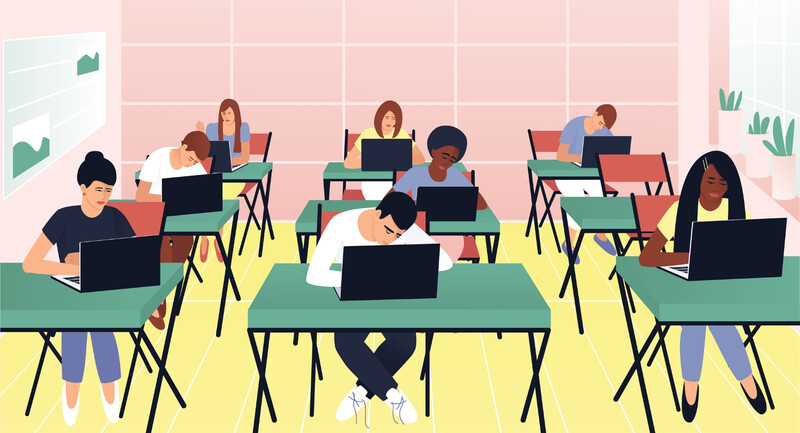Imagine two scenarios:
Scenario A: You're a student in a post-graduate level course. The professor returns an assignment that you’ve worked on with the words insufficient information and a grade that fails to meet your expected outcome.
Now stop and reflect.
Scenario B: You're a student in a post-graduate level course. The professor returns your assignment without a grade but with the following comments and questions: I’m interested in where you're going with this. Your paper left me fascinated. How different would this work be if you took this approach...? What effect might you have on your audience...? If someone with a different perspective experienced this, would they feel the same? How would you feel listening to this? Have someone read it out loud to you so that you can feel the power of what you’re saying. Let your emotion navigate this material from another direction.
Now stop and reflect.
What feelings might arise as a result of imagining yourself as student A?You're frustrated, puzzled perhaps. Feelings of defeat have surfaced and you're probably prepared for a verbal exchange that won't lead to anything beneficial.What feelings might arise as a result of imagining yourself as student B?You can see potential in your work and where you can improve it. You’re encouraged to think about next steps and feel prepared to keep going. If you weren’t feeling positive about your work before, your confidence may have been elevated.
Doctoral student @SavannahClawson provides a powerful visual on her Twitter account that brings the effects of feedback to life. After receiving stinging feedback from a professor on her thesis, Clawson wrote the professor's comments in red ink on a T-shirt. The shirt reveals phrases like “pay more attention to structure!” as well as single words like “vague,” "unclear,” and “no.” In a photo of herself wearing the shirt, Clawson placed dark makeup under her eyes to convey tears and dramatize how the negative statements made her feel.
Clawson’s tweet, while intended as a joke, helps us visualize our feedback—and its impacts on students—in stark terms. Students deserve more than hollow statements and we can use images like Clawson’s to reflect on whether we are clear about the outcomes that we are looking for from student work. Such introspection can be a beautiful thing: as a former English teacher, I am confident in admitting that I wasn’t always conscious of meeting intentional feedback targets like those provided to student B because I miscalculated their impact. I waited until the end of an assignment to give students feedback, but by then it was too late—my feedback became a summative assessment, short of the formative feedback that would make a difference.
Not only was I doing a disservice to my students, I was also unfair to myself and my family by taking home so much work. Summative feedback is more work for the student and teacher because the cognitive load is increased on both ends. The effort applied becomes extraneous. This is why we tend to feel like we have so much to do and no time to do it.
We create equity in our feedback when we recognize that every student deserves to grow cognitively at their own pace.
Throughout my professional studies, I always found myself circling back to my own classroom experience as a student. When you envision yourself on the other side of the desk, you can be more purposeful about how you want to offer and receive feedback. I knew I had to change what I was doing to be more equitable to my students and to be less harmful to myself. We create equity in our feedback when we recognize that every student deserves to grow cognitively at their own pace. As an educator, it is our responsibility to help them through that without being punitive—and to accept that we could be standing in our own way. It is the responsibility of students to think through processes—and we lead them there through questions.
Asking Questions Encourages Growth
Negative statements can create a sense of finality—student A has to spend mental energy drawing conclusions while student B is free to problem solve and create. When feedback is presented unconstructively, it can bring learning to a halt.
Feedback that propels learning includes questions that allow us to enter into a different headspace. Student B isn’t stuck wondering what the professor is thinking. Instead, they are encouraged to consider how to make their work better meet its potential.
Feedback that sparks inquiry—feedback that is structured around open-ended and thought-provoking questions for students to consider—can pique students’ curiosity, encouraging them to explore further. As teachers, our questions should be aimed at optimizing student growth. General statements imply that learning is done; questions open new doors.
As teachers, our questions should be aimed at optimizing student growth. General statements imply that learning is done; questions open new doors.
There is a “student A” sitting in more classrooms than we probably care to imagine—and their capability to respond to inquiry is diminishing. When we frame feedback as negative statements, we detach our students from the processes that learning is contingent upon. In those moments, we allow remnants of an archaic practice—that which centers our perceived authority—to dictate our engagement. By getting rid of our “red pens” and providing interrogative feedback, we can open conversations with students.
Tips for Providing Question-Based Feedback
- Prior to an assignment, frame learning as a process. Create an environment where the expectation is not to “get it right” the first time in order to encourage freethinking and an approach that's more abstract. This creates the appropriate conditions for learning as a process of inquiry. This might sound like: Our assignment is designed to lead you to think like a writer, a scientist, a mathematician, or a historian. We will explore how they might think through the process of their work.
- During the assignment, begin with positive feedback and a question. Even a positive statement can’t be left alone, such as “you did a good job.” Positive statements need to be unpacked. As students work, ask questions that prompt them to reflect on where their work is currently and the possibilities of where it can lead. Ask questions that open room for various ways students might examine a topic rather than questions that direct students toward one way of thinking. As teachers, we should be mindful of student voice and how they want to approach topics and we should coach them with our questions. Your feedback here might sound like: It was great when you said…how might you promote a change in thoughts that already exist around this idea?
- After the assignment, provide feedback for how the work can continue to be cultivated. There is no end to the growth of an assignment worth giving. Your feedback here might look like: The way you told the story was very intriguing. How could you create more beyond this to extend our collective learning on this topic? This allows us to reach the highest level of Depth of Knowledge where we are extending our learning with students. This is really where students understand how meaningful the work is instead of being just another task assigned.
Questions Beyond the Classroom
Employing an interrogative feedback approach with my students has made me more mindful of how I deliver feedback to my teachers after visiting classrooms. I’m often looking for the good in their practice and helping them improve their craft with questioning and curiosity. I wonder how this might work for you.








